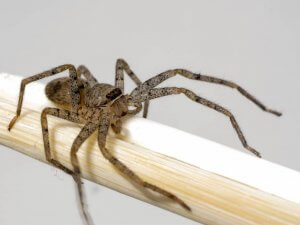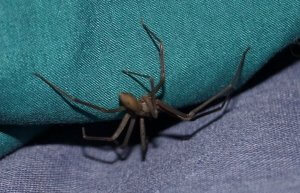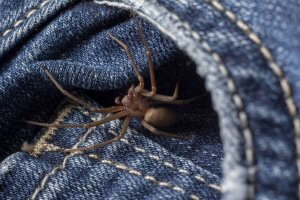Encountering a brown recluse spider can be a daunting (and frightening) experience, but knowing what to do if you get bitten by one is crucial. In our latest post, we’ll explore essential steps to take after a brown recluse spider bite, ensuring a swift and informed response to this potentially harmful situation
Their name derives from its shy, non-aggressive nature, but ironically this species is feared for it painful, toxic and dangerous bite that contains necrotic venom.
Also known as the “fiddleback” or “violin” spider, its fiddle shape can vary in size. In color, these spiders range from pale tan to deep brown. The females are twice as large as the males, reaching from one-quarter to one-half inch in length.
In daylight, they rest in dark places and by night they wander out seeking prey.
If disturbed by hunger, overcrowding or outside forces such as pesticide applications, they often crawl out of their hiding places and are seen crawling across walls, floors and other exposed surfaces.
Why Are Brown Recluse Spiders Attracted To Homes?
In the great outdoors, Brown Recluse spiders are mostly found inside caves, tree bark, leaves, brush and in log and rock piles.
Pest-maintenance specialists advise homeowners that they are lured into homes because they offer both shelter and their favorite prey; namely both live and dead insects.

They gain ingress via crevices or cracks around doors, foundations, vents or under soffits or eaves. Sometimes, they are unintentionally transported into residential buildings via boxes or furniture.
They are most comfortable in dry or warm areas of the home where there is no ventilation or air-conditioning and at temperatures between 45 and 110 degrees F.
These can include and are not limited by: close to a furnace or water heater; behind a toilet or tub; under stairs; cluttered closets; storage boxes and folded bedding.
Why Are Their Bites Often Serious?
The majority of brown recluse bites are not known to cause harm and most bites remain localized and heal within three weeks without medical intervention or serious complications.
The severity of symptoms depends on the type of spider, the amount of venom injected and individual sensitivity to venom.

In some cases, prompt medical treatment is necessary due to the fact that the venom is necrotic in nature, meaning that it can cause the eruption of skin blisters, lesions and the death of human tissue.
This type of venom is produced only by spiders from the Sicariidae family, which includes all 13 recluse species found in the United States and one of three species found in North America with toxic venom; the other two are the Black Widow and the the Chilean Recluse.
Our technicians warn home owners that their fangs are tiny, but formidable and they can only strike where skin is exposed.
Most bites occur when humans are sleeping and accidentally roll onto a spider during sleep, putting on clothing, slipping into shoes, or moving stored items harboring brown recluse spiders.

A Few Interesting Facts About Brown Recluse Spiders
Brown Recluse Spiders Do Not Construct Webs
Unlike other species, brown recluse spiders are nocturnal and catch their prey with irregular, flat webs called “retreats,” which consist of chaotically placed silk strands that are used to form egg sacs.
They do not wait for their prey to make a fatal entry, but rather chase down their targets and inject their deadly venom to over power them.
This Species Is Anatomically Different From Other Spiders
In addition to their fiddle backs, brown recluse spiders have 3 pairs of eyes instead of the usual 4.
Brown Recluse Spiders Are Known For Their Longevity
These spiders mature in about a year’s time and are known to live between 2 and four years in the wild. Like many spider species, the brown recluse can survive months without food or water.
They are extremely resilient and can tolerate up to 6 months of extreme drought and twelve months without food or water
Female Spiders Can Produce Up To 300 Eggs In One Summer
Brown recluse females lay about forty to fifty tiny yellow eggs inside a a sticky oily sac that measures less that measures less than an inch in diameter. They guard the sac until the eggs hatch and the new generation emerges.
OTC Solutions Will Not Work With Brown Recluse Infestations
Once established in a home, brown recluse spiders are often difficult to control. They can take shelter in dry, dark, undisturbed areas, and many such places exist inside homes and buildings.
Because of their secretive habits and potential health threats, treatment is best performed by pest-management professionals.
How Do You Know You Have Bitten By A Brown Recluse Spider?
These spider bites are not known to induce pain immediately afterwards, which only adds to the difficulty in providing effective treatment.
Most bites are harmless and heal within a few weeks, but sometimes the fact that the bite is not likely to be even noticed until the onset of certain tell-tale symptoms can mean the difference between life, serious harm and although rare, death.
Symptoms of brown recluse spider bites include: mild to intense pain and itching for the first 8 hours after a bite; fever, chills and body aches; a wound that turns dark blue or purple with a red ring around it, or worst of all, a lesion that has developed into an open sore surrounded by dying skin.
Severe bites can require months to fully heal, and some people suffer greatly with systemic reactions that can include: the eruption of a skin rash all over the body marked by a multitude of tiny flat purple and red spots; fevers and chills; joint pain, the swift deterioration of red blood cells and development of hemolytic anemia.
What To Do Immediately If Bitten By A Brown Recluse Spider
Medical experts advise the following :
Remain Calm And Try To Stay Relaxed
Anxiety can only worsen the situation, and you must be able to think clearly until help arrives. Clean the wound using mild soap and water, and apply an antibiotic ointment to prevent infection.
Clean The Wound
Use mild soap and water and apply an antibiotic ointment to prevent infection. Then with a marker, draw a circle around the bite and watch to see if the redness or swelling continues to expand.
Cool The Bitten Area if Possible
Apply a wet cloth to the bite, or cover with an ice pack. This will help to reduce swelling and to lessen tissue damage, burning sensations, pain. and swelling.
Never Apply A Tourniquet
This can do a lot more harm than good as it can cause infection, increase pain and spread the venom. To other parts of the body.
Try To Identify Spider Species
If possible, safely capture or try to take a picture of or transport the spider to the doctor’s office. Even if it is crushed, it can help in its identification and subsequent treatment.
Diagnosis And Treatment
A physical examination by a licensed physician will include answering some important questions concerning the bite. Describing the spider, when and where the bite occurred, which symptoms you are experiencing and what you were doing at the time are all important factors to consider when evaluating diagnosis and treatment options.
There is no one effective treatment that will work and everything depends upon the severity of the bite.
For milder cases when an open sore does not develop, a cold compress and elevating the bite area are usually sufficient.
However, if an ulcer (open sore) or dead skin (necrosis) does occur, some intervention is necessary.
Usually this involves the removal of the dead skin from the sore, which may further indicate follow up treatments to replace the dead skin with skin grafts. Medications to relieve pain may be necessary.
Tylenol, Aleve, Advil or Motrin are all safe alternatives, and antihistamines can help relive itching. Hyperbaric oxygen therapy may also be suggested to repair tissue damage.
5 Tips To Protect Your Home From Brown Recluse Spiders
We recommend the following suggestions to prevent brown recluse spiders from entering your Pittsburgh home:
Keep Home Clean And Clutter-Free
Decluttering closets and storage areas eliminates favored hiding places. By clearing areas of insects both dead and alive, food sources are no longer available as well.
Avoid Storing Firewood Against The Walls Of A Home
Keep leaves, debris and piles of wood as far away from the home entrance as possible.
Caulk and Seal All Cracks And Crevices Surrounding Home
Install tight-fitting screens on windows and doors.
Spray Closets And Storage Area With Essential Oils
While perhaps an unexpected precaution, essential oils such as lemon, mint and lavender are known to deter brown recluse spiders from seeking refuge in certain areas (closets, etc).
Dress Appropriately Wear When Cleaning Out Closets Crawl Spaces
Wear long sleeves, tuck pants into socks, gloves and boots when handling stored boxes and cleaning up garages basements, attics etc.
In Conclusion
We offer integrated solutions that work in tandem with the homeowner.
The first step involves a thorough inspection of the property to reveal the exact location and level of infestation, after which a treatment plan, usually involving several control methods, can be established.
Exclusionary tactics prevent spider ingress very effectively, but if a home is seriously infested, pesticides may be required to eliminate them.

If you think you have been bitten by a brown recluse spider, get a medical opinion on its status and threat to your health.
If the bite occurred in your home, call our teams to check out your residence for signs of infestation.
As that old saying goes, an ounce of prevention is worth a pound of cure!
 Over 300 Reviews
Over 300 Reviews 